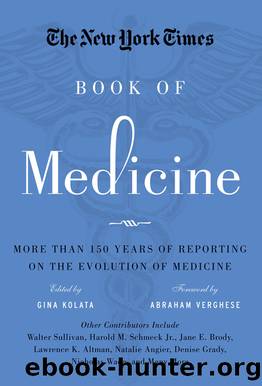The New York Times Book of Medicine by Gina Kolata

Author:Gina Kolata [Kolata, Gina]
Language: eng
Format: epub
Publisher: Sterling
In Good Health? Thank Your 100 Trillion Bacteria
By GINA KOLATA
For years, bacteria have had a bad name. They are the cause of infections, of diseases. They are something to be scrubbed away, things to be avoided.
But now researchers have taken a detailed look at another set of bacteria that may play even bigger roles in health and disease: the 100 trillion good bacteria that live in or on the human body.
No one really knew much about them. They are essential for human life, needed to digest food, to synthesize certain vitamins, to form a barricade against disease-causing bacteria. But what do they look like in healthy people, and how much do they vary from person to person?
In a new five-year federal endeavor, the Human Microbiome Project, which has been compared to the Human Genome Project, 200 scientists at 80 institutions sequenced the genetic material of bacteria taken from nearly 250 healthy people.
They discovered more strains than they had ever imagined—as many as a thousand bacterial strains on each person. And each person’s collection of microbes, the microbiome, was different from the next person’s. To the scientists’ surprise, they also found genetic signatures of disease-causing bacteria lurking in everyone’s microbiome. But instead of making people ill, or even infectious, these disease-causing microbes simply live peacefully among their neighbors.
The results, published on Wednesday in Nature and three PLoS journals, are expected to change the research landscape.
The work is “fantastic,” said Bonnie Bassler, a Princeton University microbiologist who was not involved with the project. “These papers represent significant steps in our understanding of bacteria in human health.”
Until recently, Dr. Bassler added, the bacteria in the microbiome were thought to be just “passive riders.” They were barely studied, microbiologists explained, because it was hard to know much about them. They are so adapted to living on body surfaces and in body cavities, surrounded by other bacteria, that many could not be cultured and grown in the lab. Even if they did survive in the lab, they often behaved differently in this alien environment. It was only with the advent of relatively cheap and fast gene sequencing methods that investigators were able to ask what bacteria were present.
Examinations of DNA sequences served as the equivalent of an old-time microscope, said Curtis Huttenhower of the Harvard School of Public Health, an investigator for the microbiome project. They allowed investigators to see—through their unique DNA sequences—footprints of otherwise elusive bacteria.
The work also helps establish criteria for a healthy microbiome, which can help in studies of how antibiotics perturb a person’s microbiome and how long it takes the microbiome to recover.
In recent years, as investigators began to probe the microbiome in small studies, they began to appreciate its importance. Not only do the bacteria help keep people healthy, but they also are thought to help explain why individuals react differently to various drugs and why some are susceptible to certain infectious diseases while others are impervious. When they go awry they are thought to contribute to chronic diseases and conditions like irritable bowel syndrome, asthma, even, possibly, obesity.
Download
This site does not store any files on its server. We only index and link to content provided by other sites. Please contact the content providers to delete copyright contents if any and email us, we'll remove relevant links or contents immediately.
Sapiens: A Brief History of Humankind by Yuval Noah Harari(13053)
The Tidewater Tales by John Barth(12030)
Do No Harm Stories of Life, Death and Brain Surgery by Henry Marsh(6337)
Mastermind: How to Think Like Sherlock Holmes by Maria Konnikova(6236)
The Thirst by Nesbo Jo(5786)
Why We Sleep: Unlocking the Power of Sleep and Dreams by Matthew Walker(5642)
Sapiens by Yuval Noah Harari(4537)
Life 3.0: Being Human in the Age of Artificial Intelligence by Tegmark Max(4508)
The Longevity Diet by Valter Longo(4445)
The Rules Do Not Apply by Ariel Levy(3906)
The Immortal Life of Henrietta Lacks by Rebecca Skloot(3826)
The Body: A Guide for Occupants by Bill Bryson(3802)
Why We Sleep by Matthew Walker(3773)
Animal Frequency by Melissa Alvarez(3755)
Yoga Anatomy by Kaminoff Leslie(3702)
Barron's AP Biology by Goldberg M.S. Deborah T(3632)
The Hacking of the American Mind by Robert H. Lustig(3580)
All Creatures Great and Small by James Herriot(3517)
Yoga Anatomy by Leslie Kaminoff & Amy Matthews(3396)
